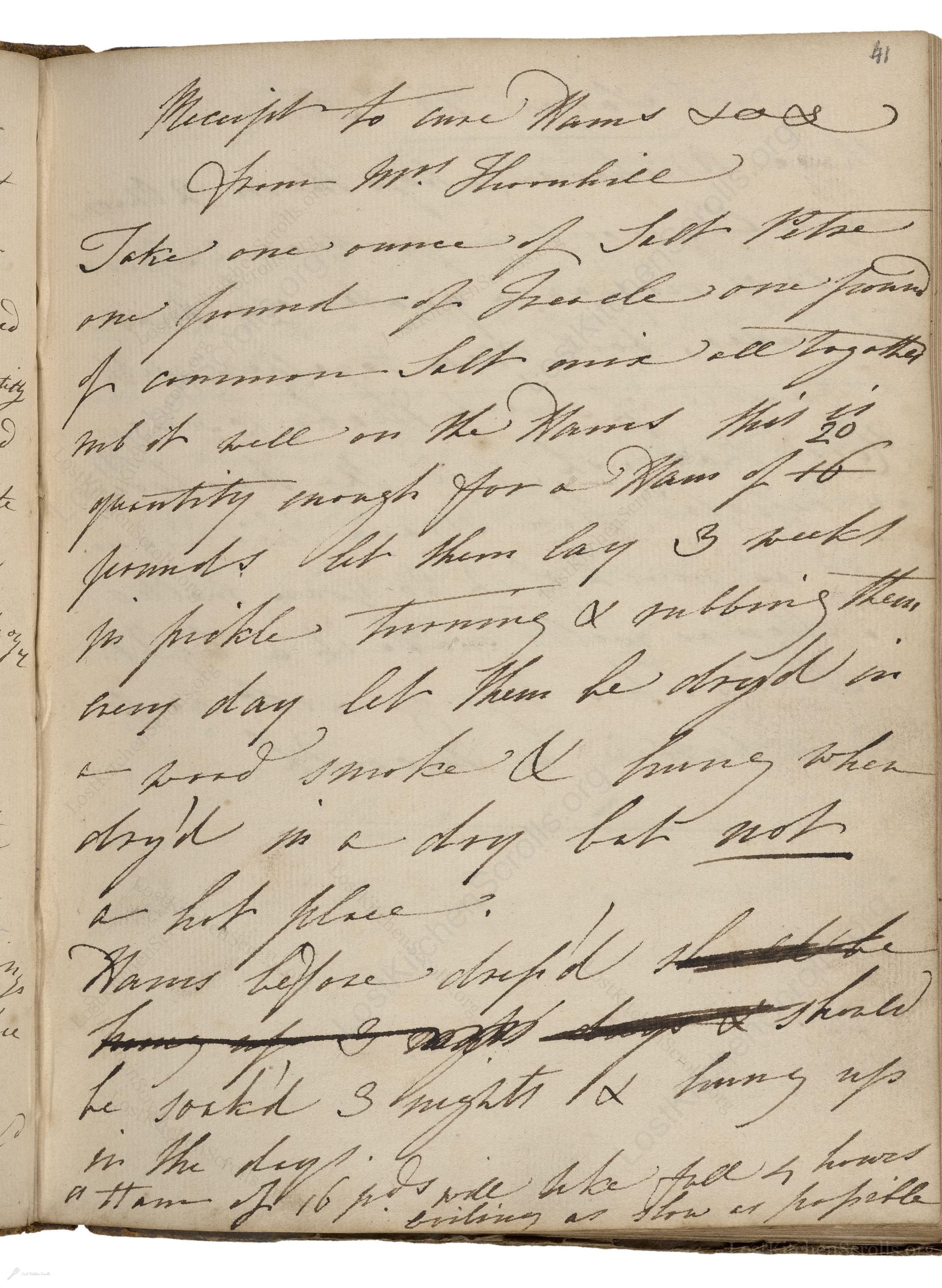Receipte To Cure Hams Loos From Mrs Thowhile
From the treasured pages of Cookbook of Elizabeth Langley
Written by Elizabeth Langley

Receipte To Cure Hams Loos From Mrs Thowhile
"Take one ounce of Salt Pitre one Pound of Prunella one pound of common Salt mixd all together rub it well on the Hams that is quantity enough for a Ham of 20 pound & let them lay 3 weeks in pickle Turning & rubbing them every day let them be dry'd in a good Smoke & hung when dry'd in a dry but not a hot Place? Hams before Dry'd shou'd be smoked & hung up in the dry place a Ham of 16 lb shou'd take full 4 hours boiling as slow as possible"
Note on the Original Text
The recipe is written in the straightforward, conversational manner typical of 18th-century English household manuscripts. Quantities are given by weight, but spellings and terms like 'salt petre' (saltpetre), 'prunella' (a purified potassium nitrate salt used for curing), and 'receipte' (recipe) reflect the period's orthography. Instruction is minimal, as it assumes the cook's familiarity with the physical processes of curing and smoking. The focus is on practical action rather than elaborate description, typical of the way women recorded kitchen knowledge for subsequent generations.

Title
Cookbook of Elizabeth Langley (1757)
You can also click the book image above to peruse the original tome
Writer
Elizabeth Langley
Era
1757
Publisher
Unknown
Background
Step into the Georgian kitchen with Elizabeth Langley's 1757 culinary collection, where refined techniques and delightful recipes await those with a taste for historic gastronomy.
Kindly made available by
Folger Shakespeare Library
This ham cure recipe comes from the mid-18th century and was recorded by Elizabeth Langley in 1757. Curing and smoking meats was an essential preservation method before refrigeration, allowing households to safely store and savor pork for months—especially over winter. The combination of salt, nitre, and smoke not only preserved the ham but also gave it that classic robust flavor beloved in British and European cuisines. Such recipes were often handed down in well-to-do households, where curing meat was both a domestic duty and a marker of good husbandry.

In the 18th century, kitchens were equipped with large earthenware or wooden tubs for brining, strong iron hooks for hanging hams, and specially constructed smokehouses or open hearths where meats could be smoked over smoldering hardwood. Hands and sturdy aprons were essential for rubbing the cure into the pork, and careful attention was paid daily to turning the ham. Once cured, the ham was hung from beams or rafters in cool, dry pantries or cellars to mature before boiling or roasting.
Prep Time
1 hr
Cook Time
4 hrs
Servings
20
We've done our best to adapt this historical recipe for modern kitchens, but some details may still need refinement. We warmly welcome feedback from fellow cooks and culinary historians — your insights support the entire community!
Ingredients
- 1 ounce saltpetre (potassium nitrate)
- 1 pound prunella salt (substitute: food-grade potassium nitrate or coarse sea salt)
- 1 pound common salt
- 1 fresh pork ham (~20 lb)
- Optional for modern palates: a handful of brown sugar for added sweetness
Instructions
- To prepare a cured ham using this 18th-century method, mix together 1 ounce of saltpetre (potassium nitrate), 1 pound of prunella salt (substituted with food-grade potassium nitrate or coarse sea salt if unavailable), and 1 pound of common salt.
- Thoroughly rub this mixture into a fresh pork ham weighing about 20 pounds.
- Place the ham in a non-reactive container (such as a ceramic or food-safe plastic tub) and allow it to cure for three weeks, turning and rubbing the ham every day to ensure even absorption of the cure.
- After curing, remove the ham from the brine and thoroughly dry it.
- Smoke the ham in cool smoke for several days, ensuring the smoke does not create excessive heat (ideally under 86°F).
- Once it has taken on sufficient flavor and dried out, hang it in a dry, well-ventilated, but not overly warm space to mature.
- When ready to cook, gently simmer a 15 pound ham for at least 4 hours, keeping the heat as low as possible to ensure the meat stays tender.
Estimated Calories
400 per serving
Cooking Estimates
Preparing and curing the ham takes time, but most of it is waiting. You will prepare the cure, rub the ham, and check it each day while it cures for three weeks. When it's ready, you smoke and hang it. Finally, when you want to serve, you simmer it for a few hours to make it tender. The calorie estimate is based on a typical serving of cooked ham.
As noted above, we have made our best effort to translate and adapt this historical recipe for modern kitchens, taking into account ingredients nowadays, cooking techniques, measurements, and so on. However, historical recipes often contain assumptions that require interpretation.
We'd love for anyone to help improve these adaptations. Community contributions are highly welcome. If you have suggestions, corrections, or cooking tips based on your experience with this recipe, please share them below.
Join the Discussion
Rate This Recipe
Dietary Preference
Main Ingredients
Occasions

Den Bockfisch In Einer Fleisch Suppen Zu Kochen
This recipe hails from a German manuscript cookbook compiled in 1696, a time whe...

Die Grieß Nudlen Zumachen
This recipe comes from a rather mysterious manuscript cookbook, penned anonymous...

Ein Boudain
This recipe comes from an anonymous German-language manuscript cookbook from 169...

Ein Gesaltzen Citroni
This recipe, dating from 1696, comes from an extensive anonymous German cookbook...
Browse our complete collection of time-honored recipes



